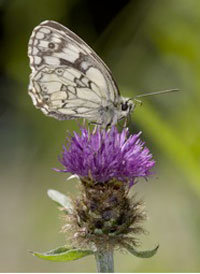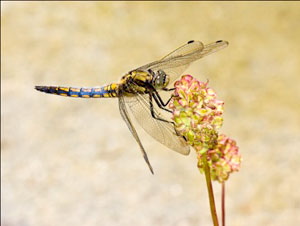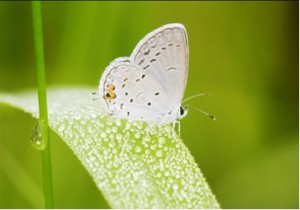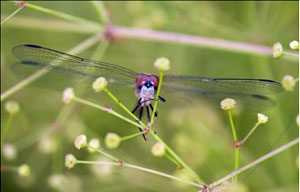Wildlife Photography and Field craft

Woods can be wildlife havens, especially if there are streams, ponds and wildflower areas, and taking photographs can add even more enjoyment to owning woodland. Photography has become very popular with the advent of digital cameras and camera phones. Taking good photographs is more difficult to achieve, and taking good photographs of wildlife is more difficult still. The problem with wildlife is that it does not usually keep still! Learning field craft is an essential part of wildlife photography, but learning takes some time. You must know something about your quarry – how to recognise signs of its presence, when to see it, how to track it and, most important of all, how to get close enough without it disappearing.
Dragonflies and butterflies are a little easier to photograph as they do not usually move far away when you approach, but this is balanced by the fact that they are small and you need to get very close if you want something other than a coloured dot in the middle of the picture.
How to approach
Dragonflies and butterflies tend to concentrate on quite a small area, and will often return to a favourite perch or flower stalk. Standing to one side and observing, then moving into position and waiting can often work well – at other times stalking is required.
Stalking
Both are very sensitive to movement, especially dragonflies who literally have eyes in the back of their head, as well as the side and front. Very slow, steady steps are essential and slow body movements. It is easy to get close and then spoil it by moving the camera too fast. Patience is essential, and it is possible to spend hours tracking your quarry before getting the shot, but the more difficult a shot is, the more satisfaction you will get once successful. And of course there are those days when dozens of good shots can be taken in one session – rare events, but ones you will remember for some time.
Taking the shot.
As you have to get close to the subject – sometimes as close as a few centimetres, it can be difficult to get all of the subject in focus as the depth of field is small. Taking the subject from the side or from the top, makes it easier to be successful - see featured image (above) of a Marbled White butterfly on Knapweed.
 The aim is to have a sharp image of the subject with a blurred background. This is achieved by determining the Depth of Field, that is, the distance over which a subject is in focus. Taking the picture of the Black-tailed Skimmer from the side keeps it all in focus.
The aim is to have a sharp image of the subject with a blurred background. This is achieved by determining the Depth of Field, that is, the distance over which a subject is in focus. Taking the picture of the Black-tailed Skimmer from the side keeps it all in focus.
Aperture size – this not only controls the amount of light entering the camera but also affects depth of field. A small aperture (f/11 to f/16) is ideal for dragonflies as it helps keep the subject in focus throughout.
Choice of background
Having a blurred background makes for a better image as the background is not a distraction. If there is too much vegetation, it can be difficult to separate the subject from the background, so choosing the background is important. Taking a picture of a dragonfly in the middle of a bush is unlikely to be successful, as it will be difficult to blur the background and keep the dragonfly focused. Try to keep some distance between the subject and the background.
With luck you can achieve a sharp subject and artistic surroundings. For example, see the image (below) of a very small blue butterfly with dew drops. Don’t be too tied to convention though. The dragonfly shot is one of my favourites as I find it amusing, and I call it 'hanging on'. Getting all of the dragonfly in focus is not always important.
Getting sharp images
Mastering field craft is only the first step. Getting a sharp image is possibly the most difficult thing to achieve. As soon as one gets close to a subject, even tiny movements can lead to a blurred image. Using a tripod helps keep the camera steady, but is not very suitable as it makes it difficult to track fast moving subjects like butterflies and dragonflies. A monopod is a good compromise.
However, even if you have super - steady hands, the subject may move or the wind may move the perch. In these conditions a high shutter speed is required – at last 1/250 of a second. Using a small aperture can make this difficult to achieve and if it is not a bright sunny day, it may be impossible. I usually use flash for dragonflies and butterflies. Even if it is very bright and sunny, it is worth using flash as it helps to overcome the problems of too much contrast giving harsh colours.
Equipment
I would always recommend a digital SLR camera rather than a compact camera as they allow much more control. Different lenses are required for nature photography – a lens suitable for wildflower images (50mm) would be useless for bird photography which need much longer lenses (300mm as a minimum). There are now many good cameras, so actual brand is not important. Canon and Nikon are regarded as the top brands especially as they have a good range of high quality lenses, but there are many other brands which will give good results. For wildlife, the photographer matters more, plus good field craft of course! All of the above were taken with a Canon 1Ds MK3, a 180mm lens and a Canon macro ring light flash unit.
Susan Young, ARPS
Susan is a photographer and writer living in South Devon. She is a contract photographer for a large mining company, and is at present working on a book of wildlife for them. She is the official photographer for Devon Wildlife Hospital and has worked with the Barn Owl Trust and other organisations. She is planning a course on Wildlife Photography and Field Craft, working with two experts on wildlife field craft and based in South Devon. The residential course is from 23rd to 26th May 2011. It will cover field craft for butterflies and dragonflies together with deer, birds of prey and other wildlife. Further details can be found on Susan's website www.susanyoung-photography.co.uk , alternatively email her at [email protected].
Comments are closed for this post.


